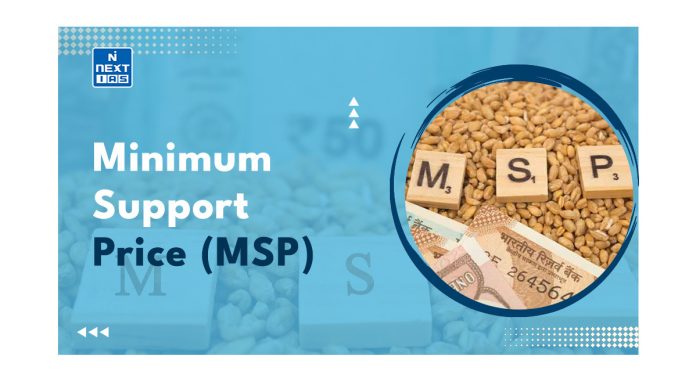Under Minimum Support Price (MSP), the Commission for Agricultural Costs & Prices (CACP) recommends prices for 23 specific crops and a fair and remunerative price for sugarcane. The CACP is a department of the Ministry of Agriculture and Farmers Welfare. This article aims to provide a comprehensive overview of the Minimum Support Price (MSP) and its calculation, benefits & issues & way forward.
How is the Minimum Support Price (MSP) Calculated?
The CACP takes into account various factors when recommending MSP, such as cultivation costs, supply, and demand situations, market price trends (both domestic and global), and the impact on consumers, and the environment.
The CACP considers three types of production costs:
1. A2
2. A2+FL
3. C2
- A2 covers direct costs incurred by farmers, including expenses on seeds, fertilizers, pesticides, labor, and more.
- A2+FL includes A2 costs and the value of unpaid family labor.
- C2 is a more comprehensive cost that also considers rentals and forgone interest on owned land and capital assets, on top of A2+FL.
The final decision on Minimum Support Price levels and other recommendations is made by the Cabinet Committee on Economic Affairs (CCEA) of the Union government.
How Does Minimum Support Price Benefit Farmers?
- Income Security: MSP guarantees farmers a minimum price for their crops, ensuring a stable income and protecting them from market price fluctuations.
- Price Stability: MSP helps stabilize the prices of agricultural products, preventing extreme fluctuations and ensuring affordable prices for consumers.
- Encourages Production: Minimum Support Price motivates farmers to increase their agricultural production by providing them with a fair price for their produce.
- Food Security: MSP promotes a steady food supply by encouraging farmers to produce staple crops, reducing dependence on imports, and enhancing domestic food security.
What are the Issues with India’s Minimum Support Price (MSP) Regime?
- Procurement Focus: The current MSP regime is primarily aimed at fulfilling the requirements of the National Food Security Act (NFSA) rather than aligning with domestic market prices. It functions more like a procurement price than a genuine MSP.
- The Dominance of Wheat and Paddy: The skewed focus on MSP for rice and wheat leads to excessive production of these crops, discouraging farmers from cultivating other crops and horticulture products that have higher demand.
- Ineffective Implementation: According to the Shanta Kumar Committee’s 2015 report, only 6% of farmers benefit from the Minimum Support Price. This means that 94% of farmers in the country do not receive the intended advantages of the MSP.
Why is there a Demand to Legalize MSP?
| Farmers Get Lower Prices | Farmers across India often receive prices for their crops that are below the officially declared MSP. Since MSPs lack legal backing, farmers cannot enforce these prices as a right. |
| Limited Government Procurement | The government’s actual purchase of crops at MSP is restricted. Only about one-third of wheat and rice crops and 10%-20% of selected pulses and oilseeds are procured at MSP rates. The majority of farmers do not have access to this benefit. |
What are the Challenges with Legalizing MSP?
| The Unsustainability of Statutory MSP | Legalizing MSP poses challenges as a fixed predetermined price could deter private traders from participating when there is excess production and a decline in market prices. This would result in the government becoming the primary buyer of most crops, which is not a sustainable approach. |
| Potential for Corruption and Leakage | Legalizing MSP could increase the risk of corruption and improper distribution or diversion of crops from warehouses, ration shops, or during transportation. |
| Disposal Challenges | While selling cereals and pulses through the public distribution system is relatively straightforward, it becomes more complex to dispose of crops like niger seed, sesamum, or safflower. |
| Inflationary Impact | Higher procurement costs under MSP could lead to increased prices of food grains, causing inflation that would ultimately affect the poor. |
| Impact on Farm Exports | If MSP prices exceed prevailing international rates, it could negatively impact India’s agricultural exports, which currently contribute 11% to total commodity exports. |
Way Forward
- Diversify Agriculture: Emphasize investments in animal husbandry, including fisheries, and fruits and vegetables, which are more nutritious and have the potential for higher income generation.
- Encourage Private Sector Involvement: The government should incentivize the private sector to develop efficient value chains for agriculture, following a cluster approach.
- True MSP Intervention: A genuine MSP should involve government intervention when market prices fall below a predefined level, especially in cases of excess production, oversupply, or price collapse due to international factors.
- Incentivize Desirable Crops: Minimum Support Price can also serve as an incentive price for crops crucial for nutritional security, such as coarse cereals, pulses, and edible oils, which India relies on imports for.
About the Commission for Agricultural Costs & Prices (CACP)
| The Commission for Agricultural Costs & Prices (CACP) is an attached office of the Ministry of Agriculture and Farmers Welfare, Government of India. It came into existence in January 1965. Currently, the Commission comprises a Chairman, Member Secretary, one Member (Official) and two Members (Non-Official). The non-official members are representatives of the farming community and usually have an active association with the farming community. MSP for major agricultural products are fixed by the government, each year, after taking into account the recommendations of the Commission. As of now, CACP recommends MSPs of 23 commodities, which comprise 7 cereals (paddy, wheat, maize, sorghum, pearl millet, barley and ragi), 5 pulses (gram, tur, moong, urad, lentil), 7 oilseeds (groundnut, rapeseed-mustard, soyabean, seasmum, sunflower, safflower, nigerseed), and 4 commercial crops (copra, sugarcane, cotton and raw jute). |
Previous Year Question
Q. What do you mean by Minimum Support Price (MSP)? How will MSP rescue the farmers from the low-income trap? (150 words, 10 marks, asked in UPSC Mains-GS3-2018)









